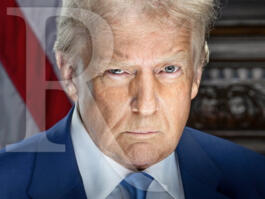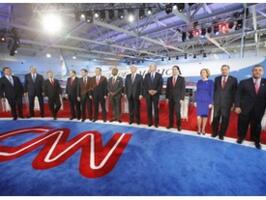Voters See Media Biased Against Trump but Not Clinton
Voters are far more likely to think the media is biased against Republican presidential front-runner Donald Trump than against his chief Democratic rival Hillary Clinton.
Forty-seven percent (47%) of Likely U.S. Voters think most reporters are biased against Trump. A new Rasmussen Reports finds that 31% disagree, but 22% are not sure. (To see survey question wording, click here.)
By comparison, just half as many (23%) believe the media is biased against Clinton. Most voters (59%), in fact, say the media is not biased against the former first lady and secretary of State. Eighteen percent (18%) are undecided.
Sixty-seven percent (67%) of Republicans and 50% of unaffiliated voters feel the media is biased against Trump, but just 26% of Democrats agree. Only 13% of GOP voters and 20% of unaffiliateds believe the media is biased against Clinton, compared to 34% of Democrats. But even a plurality (44%) of voters in Clinton’s own party says the media is not biased against her.
This survey was taken before perhaps the biggest controversy yet involving Trump, his call in the wake of the San Bernardino massacre for barring all Muslims from entering the United States until the federal government can figure out how to do a better job keeping out radical Islamic terrorists.
Sixty-six percent (66%) of all voters say the news media focus too much on Trump and Clinton at the expense of the other presidential candidates. Just six percent (6%) think there is too little focus on the two front-runners. Twenty percent (20%) describe the level of media coverage as about right.
Seventy-five percent (75%) believe that when it comes to covering prospective presidential candidates, the media is more interested in creating controversies about them than it is in reporting where they stand on the issues.
(Want a free daily e-mail update? If it's in the news, it's in our polls). Rasmussen Reports updates are also available on Twitter or Facebook.
The survey of 1,000 Likely Voters was conducted on December 2-3, 2015 by Rasmussen Reports. The margin of sampling error is +/- 3 percentage points with a 95% level of confidence. Field work for all Rasmussen Reports surveys is conducted by Pulse Opinion Research, LLC. See methodology.
Seventy-one percent (71%) of voters believe that when covering a political campaign, most reporters try to help the candidate they want to win. Republicans and unaffiliated voters are more skeptical of the media than Democrats are.
That’s comparable to attitudes in 2012 just three months before Election Day and four years before that right before the 2008 election.
When it comes to the level of coverage given the two front-runners, Republicans and Democrats are in general agreement. Unaffiliated voters believe even more strongly that they receive too much coverage at the expense of the other candidates.
Men feel much more strongly than women that the media is biased against Trump. Most women agree the media is not biased against Clinton, but they don’t believe that as strongly as men do.
Voters of all ages tend to think the media is biased against Trump. Those under 40 are more likely than their elders to believe the media is also biased against Clinton, but younger voters still see the media as more biased against Trump than against Clinton.
But then voters in nearly all demographic categories see more bias against Trump than against Clinton.
Among voters who rate the current level of media focus as about right, 51% say the media is biased against Trump, but just 20% feel the media is biased against Clinton.
In a survey earlier this year, 55% of Republicans said they expect most reporters to try to help Clinton’s campaign. Just 17% of Democrats and 39% of unaffiliated voters agreed.
Media coverage of the immigration policies of Clinton and Trump is a case in point.
Just 23% of voters expect reporters to offer unbiased coverage of the 2016 presidential race. The Republican presidential debate in late October was a textbook example of the media bias voters have complained about in surveys for years.
Additional information from this survey and a full demographic breakdown are available to Platinum Members only.
Please sign up for the Rasmussen Reports daily e-mail update (it's free) or follow us on Twitter or Facebook. Let us keep you up to date with the latest public opinion news.
The survey of 1,000 Likely Voters was conducted on December 2-3, 2015 by Rasmussen Reports. The margin of sampling error is +/- 3 percentage points with a 95% level of confidence. Field work for all Rasmussen Reports surveys is conducted by Pulse Opinion Research, LLC. See methodology.
Rasmussen Reports is a media company specializing in the collection, publication and distribution of public opinion information.
We conduct public opinion polls on a variety of topics to inform our audience on events in the news and other topics of interest. To ensure editorial control and independence, we pay for the polls ourselves and generate revenue through the sale of subscriptions, sponsorships, and advertising. Nightly polling on politics, business and lifestyle topics provides the content to update the Rasmussen Reports web site many times each day. If it's in the news, it's in our polls. Additionally, the data drives a daily update newsletter and various media outlets across the country.
Some information, including the Rasmussen Reports daily Presidential Tracking Poll and commentaries are available for free to the general public. Subscriptions are available for $4.95 a month or 34.95 a year that provide subscribers with exclusive access to more than 20 stories per week on upcoming elections, consumer confidence, and issues that affect us all. For those who are really into the numbers, Platinum Members can review demographic crosstabs and a full history of our data.
To learn more about our methodology, click here.





